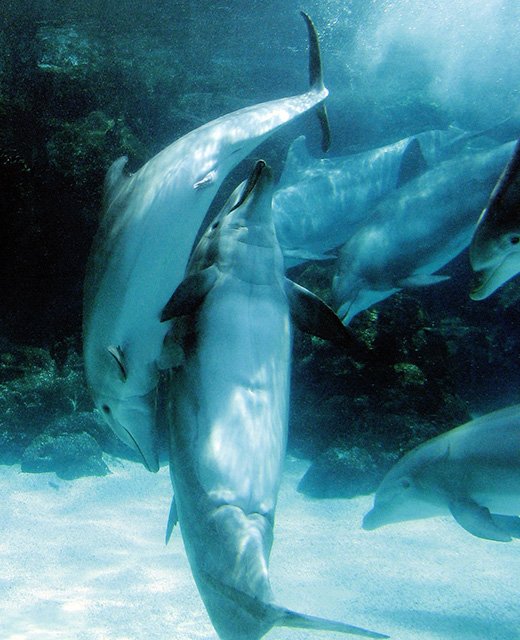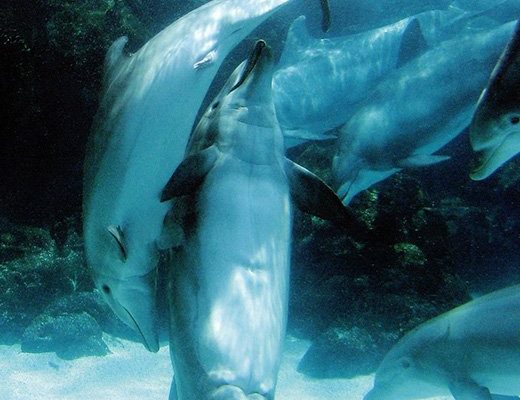
Understanding Bottlenose Dolphin Mating Behavior
The first step in the reproduction process is mating, which usually occurs in warm waters where bottlenose dolphins often gather. During the mating season, which can happen year-round in some regions, males display a range of courting behaviors to attract females. They may swim alongside potential partners, leaping out of the water, or even performing acrobatic flips. It’s like a dolphin version of a dance-off!
Here’s the thing: bottlenose dolphins are social creatures. They often form pods, which are groups that can range from a few individuals to over a hundred. Within these pods, you’ll find a complex social structure. Males may compete with one another to win a female’s affection, showing off their strength and agility. This competition can be fierce but is also vital for selecting strong mates that can contribute to healthy offspring.
Once a female is receptive, she will engage in a series of courtship behaviors. This can include a lot of physical interaction, such as rubbing against the male or swimming closely together. It’s an intimate dance that not only solidifies their bond but also helps with the actual mating process.
The Gestation Period: A Long Wait for New Life
After mating, a female bottlenose dolphin undergoes a lengthy gestation period of about 12 months. During this time, she carries her developing calf in her womb while still participating in her pod’s social activities. It’s fascinating to think about how life stirs beneath the surface, even while she chases fish or plays with friends!
During gestation, a mother dolphin will often seek out calmer waters and may become less active than usual. She’s essentially preparing for the arrival of her new baby. This period is critical as the developing calf relies entirely on its mother’s health and nutrition. A well-cared-for mother produces healthier calves, which stand a better chance of surviving in the wild.
You might be wondering about the mother’s diet during this time. Bottlenose dolphins primarily eat fish and squid. A well-balanced diet is vital; it’s all about keeping herself and her unborn calf healthy and strong. Once the calf is born, it will need to nurse frequently, so a mother must be in good shape to provide the necessary milk.
Calf Birth and Early Life
When the time comes for the calf to be born, it’s quite a sight! Typically, a mother dolphin gives birth while swimming, and the calf emerges tail-first to prevent drowning. The whole process happens quickly, often in just a matter of minutes. Once born, the calf is instinctively ready to swim to the surface for its first breath, which is a crucial moment in its life.
Immediately after birth, the mother will help the calf by nudging it to the surface. It’s a delicate dance, showcasing the bond between them. The calf is born with a thick layer of blubber that helps keep it warm in the ocean’s cool waters. This blubber is essential for survival, especially in the first few weeks of life.
For the first several months, the calf will drink its mother’s milk exclusively. Interestingly, dolphin milk is incredibly rich in fat—almost 30%—which helps the young dolphin grow quickly. As the calf develops, it will start to learn essential hunting skills by observing and mimicking its mother and other pod members. This period of learning is vital, as it sets the foundation for its future independence.
Social Structures and Parenting Roles
In bottlenose dolphin pods, parenting is often a shared responsibility. While the mother is primarily responsible for her own calf, other pod members can assist in caring for and protecting the young. This communal approach to parenting helps increase the calf’s chances of survival. Imagine a tight-knit family where everyone chips in; that’s what’s happening underwater!
Dolphins are known for their intelligence and social skills, and that shines when it comes to raising their young. They use a variety of sounds and body language to communicate. As calves grow, older dolphins help them learn vital skills, like foraging for food and social interaction. This learning process is crucial, as dolphins are often faced with challenges in their environment, from predators to changes in water quality.
It’s not uncommon to see older siblings staying close to their younger counterparts, providing extra protection as they navigate the complexities of dolphin day-to-day life. This unique social structure helps strengthen bonds within the pod, ensuring that everyone is looking out for one another.
Challenges in the Breeding Cycle
While bottlenose dolphins are highly adaptable, they face numerous challenges in their breeding and reproductive cycles. One of the biggest threats is human activity, including pollution, habitat destruction, and boat traffic. These factors can severely impact the dolphin’s ability to find food, mate, and raise their young.
Additionally, environmental changes, such as rising sea temperatures and dwindling fish populations, pose serious threats to their food sources. A mother dolphin must have a steady supply of food to support her calf, and any disruption can make that challenging. It’s not just about making sure her calf grows strong; it’s about ensuring the entire pod can thrive in a changing ocean.
With increasing coastal development and marine traffic, these beautiful creatures must navigate their world carefully. Conservation efforts are crucial in protecting their habitats and ensuring that they have the resources they need to breed successfully. There are ongoing initiatives aimed at reducing pollution and protecting marine areas, which can make a positive difference for bottlenose dolphins.
The Importance of Conservation Efforts
As we’ve seen, the breeding and reproduction of bottlenose dolphins are deeply intertwined with their ability to thrive in the wild. Conservation efforts play a vital role in ensuring that these magnificent creatures can continue to be part of our oceans. Protecting habitats, maintaining clean waters, and implementing sustainable fishing practices can all help support dolphin populations.
Organizations dedicated to marine conservation work hard to educate the public about the challenges dolphins face. They often advocate for policy changes that protect dolphins and their habitats. By raising awareness about the importance of preserving marine ecosystems, we can all contribute to the future of bottlenose dolphins.
If you have a chance to participate in beach clean-ups, support local conservation initiatives, or simply educate yourself and others about the impact of human activities on marine life, you’re playing a part in helping these dolphins thrive.
The breeding and reproduction of bottlenose dolphins give us a glimpse into their complex lives as social creatures navigating the ocean together. From courtship and gestation to community support in parenting, their behaviors reveal a rich tapestry of interactions. Understanding these aspects is not only fascinating but essential in highlighting the importance of conserving their habitats.
As we move forward, let’s not forget that our actions can significantly impact these incredible animals. By caring for our oceans and supporting conservation efforts, we can ensure that bottlenose dolphins continue to grace our waters for generations to come. So next time you hear about dolphins, remember there’s a whole world of family, love, and survival happening beneath the waves.

